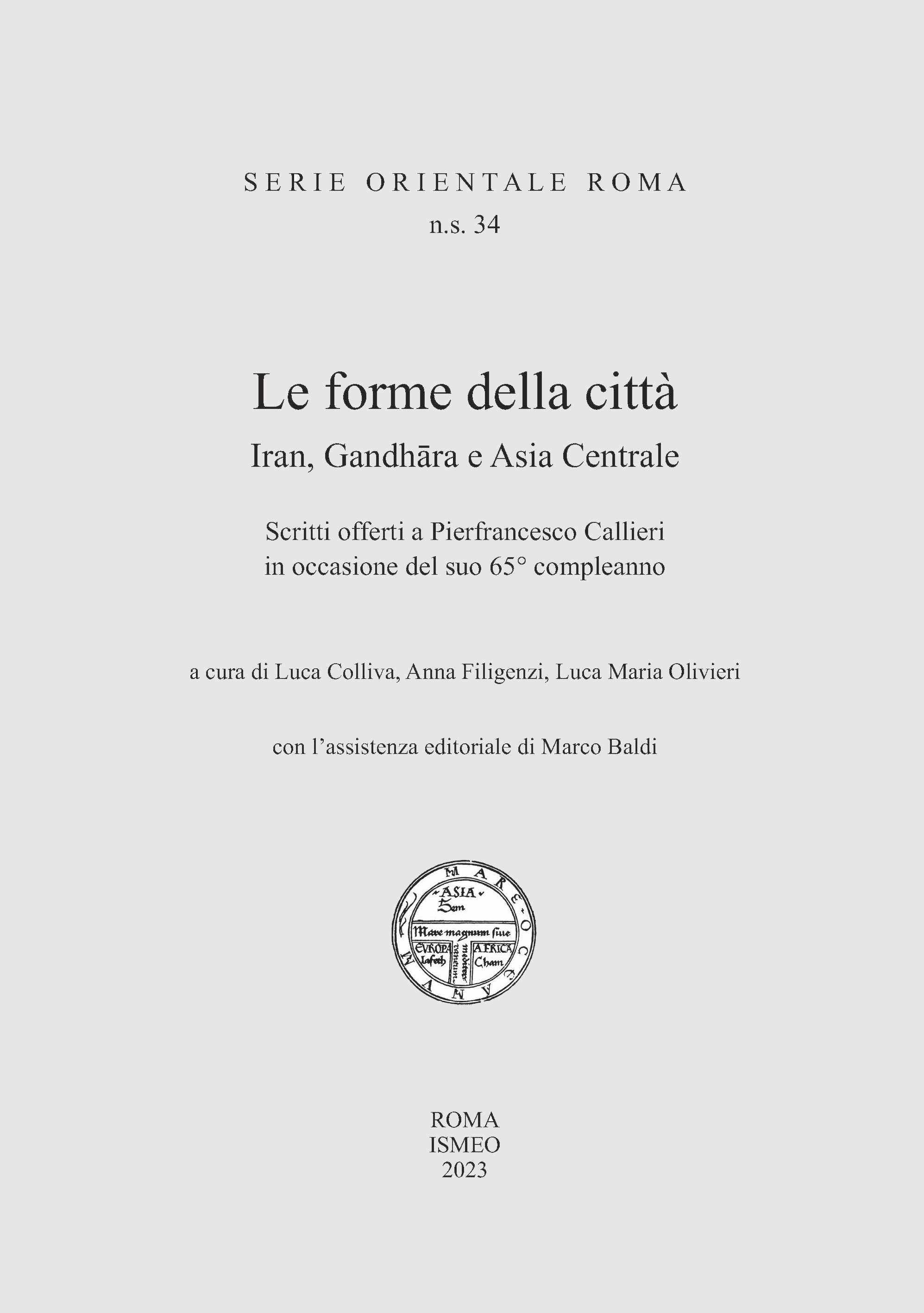Le forme della città
Iran, Gandhara e Asia Centrale
Scritti offerti a Pierfrancesco Callieri
in occasione del suo 65° compleanno - SERIE ORIENTALEROMA n.s. 34
- Anno: 2023
- Autore/i: a cura di Luca Colliva, Anna Filigenzi, Luca Maria Olivieri con Marco Baldi
- Catalogo: Scienze e Lettere
- Argomento: Orientalistica
- Collana: Serie Orientale Roma
- ISBN: 978-88-6687-219-1
- ISSN: 0582-7906
La preparazione da parte di ISMEO di questo volume in onore di Pierfrancesco Callieri rappresenta qualcosa di più dell’edizione di un insieme di studi con cui allievi e amici rendono solitamente omaggio a un collega internazionalmente stimato nel momento della sua massima maturità scientifica.
Come spiegano nelle pagine che seguono i curatori di questo volume, è stata determinante in ogni fase della biografia scientifica di Pierfrancesco Callieri la scuola di Domenico Faccenna, con la particolare accentuazione da essa veicolata della dimensione pragmatica dello scavo, da una parte, e della meticolosità della documentazione e dello studio che seguono l’acquisizione dei dati, dall’altra.
Il ‘metodo Faccenna’ (“un sistema forse un po’ spartano, ma efficace […] fatto di grande rispetto, regole precise, tanto rigore”, nelle parole di Pierfrancesco stesso), su cui l’amico qui festeggiato è tornato più volte, guidò il giovanissimo studioso, poco più che ventenne, fin dal suo esordio, con lo scavo della missione IsMEO nello Swat nel monastero buddhista di Saidu Sharif. Le cinque campagne di scavo che ne seguirono furono impeccabilmente illustrate in P.C., Saidu Sharif I (Swat, Pakistan). 1. The Buddhist Sacred Area. The Monastery (IsMEO Reports and Memoirs, XXIII 1, Rome 1989), dove, nelle pagine introduttive della pubblicazione (ibid., p. ix), Pierfrancesco ricorda i dettagli degli insegnamenti del suo maestro, relativi perfino al modo di predisporre il rapporto di scavo stesso.
(dalla premessa di ADRIANO V. ROSSI)
CONTENTS
Prefazione/Preface di Adriano V. Rossi
Premessa/Foreword di Luca Colliva, Anna Filigenzi, Luca M. Olivieri
Bibliografia/Bibliography di Pierfrancesco Callieri
IRAN
A. Askari Chaverdi, M. Hossein Talebian, An Analysis on the Function of Kabah-ye Zardosht in Naqsh-e Rostam in the Archaeological Context of Shahr-e Parseh
A. Askari Chaverdi, From Seminar to World Heritage List. Archaeological Landscape of Sasanian Fars: Firuzabad, Bishapur, and Sarvestan
L. Colliva, Dal monumento alla città, una “via mediana” per l’archeologia
J. Cuny, Nouvelles «Épaves» de la vaisselle perse en pierre: deux mortiers de Suse
B. Genito, Remains of Domestic Buildings of Probable Achaemenid Date in Eastern Iran
S. Gondet, R. Boucharlat, The Firuzi Area within the Archaeological Context of Persepolis: a Reappraisal, Based on Mapping and Chronological Remarks
W.F.M. Henkelman, Pitch and “All Happiness.” Bitumen in the Persepolis Archives
D. Huff, Remarks on the Development of Sasanian Fire Temples
E. Matin, From Tol-e Takht to the Persian Gulf: Pierfrancesco Callieri and the Landscapes of Ancient Fars
D.T. Potts, Race and Racialism in Ancient Elam: some Observations on the Archers Frieze at Susa
M. Rahbar, The Sasanian Tower of Silence at Bandian: a Refutation of the Excarnation Theory
E.W. Sauer, J. Nokandeh, H.O. Rekavandi, The Military Origins of Cities on the Sasanian Empire’s Northern Frontiers
J. Wiesehöfer, Iran: Remarks on the Importance of a Major Area between 550 BCE and 650 CE
ARMENIA, IRAQ E ASIA CENTRALE
M. Badalyan, Some Notes on the Statues of a Bull and a Cow with Its Calf in the Haldi Temple of Musasir
H.-P. Francort, Sur les traces de sphinx centrasiatiques en Bactriane, dans l’Altaï, au Xinjiang, et du Martichoras en Bactriane et en Inde (IVe Siècle BCE-I/IIe Siècle CE)
A. Invernizzi, The Adiabenian Rider. A Note on the Parthian Rock Relief at Khinis-Bavian
A. Ivantchik, Iranians in the Bosporus: a New Inscription of the Roman Period
B. Kaim, Stucco Decoration in the Fire Temple at Mele Hairam
C. Lippolis, The Layout of Parthian Nisa: an Updated Overview
C. Lo Muzio, The “Red Hall” Murals in the Varakhsha Palace (Bukhara Oasis): Hints for a New Reading
P.B. Lurje, A Worship Scene on the Wall of Hisorak Palace
B. Lyonnet, Questions on the Origin of the Iron Age Circular Fortresses in Central Asia and of Monumental Architecture in Sogdiana
V. Messina, Polis o Cosmopoli? Percezioni e realtà della città antico-orientale di età ellenistica
C. Rapin, Sources antiques sur Maracanda-Zariaspa (La Sogdiane entre Spitamène et Alexandre Le Grand)
F. Sinisi, Cesura e innovazione nella glittica e nella numismatica del Nord-Ovest indiano tra epoca saka-pahlava e kushana
G. Vignato, Boundaries and Gates in Rock Monasteries Kucha as a Case Study
PAKISTAN
M. Ashraf Khan, T. Saeed, The Contribution of the Italian Archaeological Mission in Swat (Pakistan): a Tribute to Pierfrancesco Callieri
S. Baums, The Dharmarjika Bowl and Slab from Butkara I
P. Brancaccio, Between Storytelling and Performance. The Narrative of the Buddha’s Life in Urbanized Gandhara
O. Coloru, Demetrio Rex Indorum, Menandro I e Barikot. Un’ipotesi di lavoro
A. Filigenzi, Il Tempio Vishnuita di Barikot: nuovi dati archeologici e qualche riflessione sul paesaggio identitario
Ghani-ur-Rahman, A Fitting Tribute to Prof. Pierfrancesco Callieri
E. Iori, The Achaemenid “Mirage” in Gandhara: a Study of the 5th-4th Century BCE Pottery from Barikot
L.M. Olivieri, M. Minardi, Scavare a Barikot. Le fasi tardo-antiche
C.A. Petrie, Regional Variations in the Ceramic Assemblages of the Borderlands of Pakistan during the Hindu-Shahi and Early Islamic Periods. Some Observations about Barikot and Akra, and the Broader Patterns They Reveal
M. Vidale, R. Micheli, Out of Context, but Part of a Broader Picture. A Hand-Axe from Late Bronze Age Barikot
Contributori/Contributors
F.to 17x24, pp. 720, Brossura filo refe, Ill.



